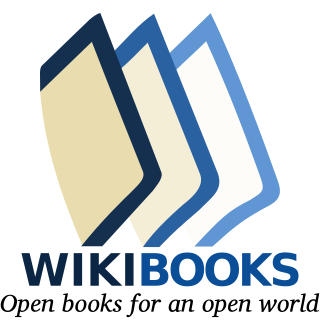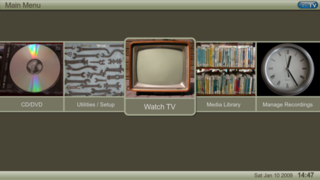Related Research Articles

In computer networking, multicast is group communication where data transmission is addressed to a group of destination computers simultaneously. Multicast can be one-to-many or many-to-many distribution. Multicast should not be confused with physical layer point-to-multipoint communication.

Digital Video Broadcasting (DVB) is a set of international open standards for digital television. DVB standards are maintained by the DVB Project, an international industry consortium, and are published by a Joint Technical Committee (JTC) of the European Telecommunications Standards Institute (ETSI), European Committee for Electrotechnical Standardization (CENELEC) and European Broadcasting Union (EBU).
Copy protection, also known as content protection, copy prevention and copy restriction, describes measures to enforce copyright by preventing the reproduction of software, films, music, and other media.
Integrated Services Digital Broadcasting is a Japanese broadcasting standard for digital television (DTV) and digital radio.

Wikibooks is a wiki-based Wikimedia project hosted by the Wikimedia Foundation for the creation of free content digital textbooks and annotated texts that anyone can edit.
A broadcast flag is a bit field sent in the data stream of a digital television program that indicates whether or not the data stream can be recorded, or if there are any restrictions on recorded content. Possible restrictions include the inability to save an unencrypted digital program to a hard disk or other non-volatile storage, inability to make secondary copies of recorded content, forceful reduction of quality when recording, and inability to skip over commercials.

Digital Video Broadcasting - Satellite - Second Generation (DVB-S2) is a digital television broadcast standard that has been designed as a successor for the popular DVB-S system. It was developed in 2003 by the Digital Video Broadcasting Project, an international industry consortium, and ratified by ETSI in March 2005. The standard is based on, and improves upon DVB-S and the electronic news-gathering system, used by mobile units for sending sounds and images from remote locations worldwide back to their home television stations.

MythTV is a free and open-source home entertainment application with a simplified "10-foot user interface" design for the living room TV. It turns a computer with the necessary hardware into a network streaming digital video recorder, a digital multimedia home entertainment system, or home theater personal computer. It can be considered a free and open-source alternative to TiVo or Windows Media Center. It runs on various operating systems, primarily Linux, macOS, and FreeBSD.
Globally Executable MHP (GEM) is a DVB specification of a Java based middleware for TV broadcast receivers, IPTV terminals and Blu-ray players. GEM is an ETSI standard and an ITU "Recommendation”. GEM defines a set of common functionalities which are independent from the signaling and protocols of a specific transmission network and enables to write interoperable Java applications for TV. GEM is not intended to be directly implemented, but rather forms the basis for broader specifications targeting a particular network infrastructure or class of device. GEM defines profiles for different device classes (targets) – these define the set of available features of GEM for this device class. Currently GEM defines targets for broadcast, packaged media (Blu-Ray) and IPTV. Combinations of these targets can be combined into a hybrid GEM platform, which enables to build devices with multiple network interfaces, such as a combined broadcast/IPTV set-top box.
Active Directory Rights Management Services is a server software for information rights management shipped with Windows Server. It uses encryption and a form of selective functionality denial for limiting access to documents such as corporate e-mails, Microsoft Word documents, and web pages, and the operations authorized users can perform on them. Companies can use this technology to encrypt information stored in such document formats, and through policies embedded in the documents, prevent the protected content from being decrypted except by specified people or groups, in certain environments, under certain conditions, and for certain periods of time. Specific operations like printing, copying, editing, forwarding, and deleting can be allowed or disallowed by content authors for individual pieces of content, and RMS administrators can deploy RMS templates that group these rights together into predefined rights that can be applied en masse.
The High-Definition Audio-Video Network Alliance (HANA) was a cross-industry collaboration of members addressing the end-to-end needs of connected, HD, home entertainment products and services. Leading companies formed the organization from the four industries most affected by the HD revolution: content providers, consumer electronics, service providers, and information technology. HANA created design guidelines for secure high-definition audio-video networks that would speed the creation of new, high-quality, easy-to-use HD products. HANA membership was open to all companies involved in the digital entertainment industry. HANA was dissolved in September 2009, and the 1394 Trade Association assumed control of all HANA-generated intellectual property.
DVB Content Protection & Copy Management, often abbreviated to DVB-CPCM or CPCM, is a digital rights management standard being developed by the DVB Project. Its main application is interoperable rights management of European digital television, though other countries may also adopt the standard.
Card sharing, also known as control word sharing, is a method of allowing multiple clients or digital television receivers to access a subscription television network with only one valid subscription card. This is achieved by electronically sharing a part of the legitimate conditional access smart card's output data, enabling all recipients to gain simultaneous access to scrambled DVB streams, held on the encrypted television network.
DVB-SH is a physical layer standard for delivering IP based media content and data to handheld terminals such as mobile phones or PDAs, based on a hybrid satellite/terrestrial downlink and for example a GPRS uplink. The DVB Project published the DVB-SH standard in February 2007.
This is a comparison of digital video recorder (DVR), also known as personal video recorder (PVR), software packages. Note: this is may be considered a comparison of DVB software, not all listed packages have recording capabilities.

Free content, libre content, libre information, or free information, is any kind of functional work, work of art, or other creative content that meets the definition of a free cultural work, meaning "works or expressions which can be freely studied, applied, copied and/or modified, by anyone, for any purpose."
Japanese copyright laws consist of two parts: "Author's Rights" and "Neighbouring Rights". As such, "copyright" is a convenient collective term rather than a single concept in Japan. Japan was a party to the original Berne convention in 1899, so its copyright law is in sync with most international regulations. The 1899 law protected copyrighted works for 30 years after the author's death. Law changes promulgated in 1970 extended the duration to 50 years. However, in 2004 Japan further extended the copyright term to 70 years for cinematographic works. At the end of 2018, as a result of the Trans-Pacific Partnership negotiations and a requirement stemming from the EU–Japan Economic Partnership Agreement., the 70 year term was applied to all works. This new term was not applied retroactively; works that had entered the public domain between 1999 and 29 December 2018 (inclusive) due to expiration remained in the public domain.
Digital rights management (DRM) is the management of legal access to digital content. Various tools or technological protection measures (TPM) like access control technologies, can restrict the use of proprietary hardware and copyrighted works. DRM technologies govern the use, modification and distribution of copyrighted works and of systems that enforce these policies within devices. DRM technologies include licensing agreements and encryption.

The Digital Millennium Copyright Act (DMCA) is a 1998 United States copyright law that implements two 1996 treaties of the World Intellectual Property Organization (WIPO). It criminalizes production and dissemination of technology, devices, or services intended to circumvent measures that control access to copyrighted works. It also criminalizes the act of circumventing an access control, whether or not there is actual infringement of copyright itself. In addition, the DMCA heightens the penalties for copyright infringement on the Internet. Passed on October 12, 1998, by a unanimous vote in the United States Senate and signed into law by President Bill Clinton on October 28, 1998, the DMCA amended Title 17 of the United States Code to extend the reach of copyright, while limiting the liability of the providers of online services for copyright infringement by their users.
The Vu+, is a series of Linux-powered DVB satellite, terrestrial digital television receivers, produced by Korean multimedia brand Ceru Co., Ltd.
References
- ↑ "Copy protection plan squeezes home users", an EE Times news article